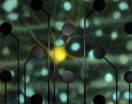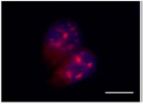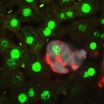(Press-News.org) If you have it, you probably don't know it. Cytomegalovirus, or CMV, is perhaps one of the biggest pathogens you've never heard of—big, both proportionately and epidemiologically. It contains approximately 200 genes, compared to HIV's paltry 18, and it's everywhere. You can catch it as a preschooler salivating over blocks, or as a teenager experiencing your first kiss. Once you have it, you have it for life.
Good news: If you're healthy, it's harmless. Your T cells keep it in check, and you'll be none the wiser.
Bad news: If you have any medical condition that dampens your immune system, such as HIV infection or a recent organ transplant, the virus can assert itself with a vengeance. The results, sometimes, are life-threatening.
Researchers in the lab of Steven Gygi, professor of cell biology at Harvard Medical School, report that they have discovered a menu of tactical secrets CMV employs. Using a technological platform commonly used in physics and chemistry called mass spectrometry, the researchers were able to describe the dynamics of a CMV infection in a fibroblast, or connective tissue cell, over a three-day course of infection. As a result the researchers discovered ways CMV evades the immune system, and also showed how certain viral proteins target and destroy human proteins that defend against infection.
"This is an entirely new way of studying the behavior and tactics of viruses," said Gygi.
These results are published June 5 in Cell.
Mass spectrometry has existed for more than a century, used primarily by physicists and chemists to describe and measure small molecules. Inside the mass spectrometer, or mass spec tool, molecules are shattered by an electric charge and then brought through a magnetic field where they are characterized one by one.
Traditionally, this approach has not been relevant for the life sciences since biomolecules such as proteins are too large for this process. But over the last 15 years, Gygi has been innovating ways to incorporate mass spec into biology. In one approach, "electrospray," subunits of proteins called peptides are vaporized and then sprayed into a chamber where they are broken apart by helium. The mass spec then sequences the amino acids of each peptide. The molecules are "reassembled" through an algorithm that matches them to a protein database.
Michael Weekes, a postdoctoral researcher in the Gygi lab and an expert in infectious disease, decided to use mass spec for virology. He chose CMV because, for a virus that is so widespread, we actually know very little about it. "Many scientists are interested in CMV, but few if any have tried to tackle it in a comprehensive way before," he said.
Weekes took a sample of fibroblasts newly infected with CMV, harvested the proteins from both the virus and the cell, and sprayed them into the mass spec at different times over three days in order to construct a thorough trajectory of infection. The first three days of infection are particularly important since they mark a covert stage in which the virus hijacks, but hasn't yet destroyed, the cell.
The researchers were able to study approximately 8,000 total proteins, identifying not only ways that CMV evades the immune system, but also discovering a number of new therapeutic targets. Most notably, they were able to look closely at proteins that live on the cell surface. This is especially crucial since most drugs target cell surface proteins, yet these proteins are harder to study than proteins inside the cell due to their low numbers.
Weekes and his colleagues found 29 viral proteins living on the cell surface, 23 of which had not previously been discovered. Many of these CMV surface proteins deter immune cells. Others block cellular proteins that activate immunity. In other words, CMV wards off rescuers while disabling a cell's ability to defend itself.
"So much of this viral genome is dedicated to simply evading the immune system," said Weekes.
The next step, according to the researchers, would be to identify antibodies against many of these viral proteins, ideally destroying infected cells before they replicate and spread the pathogen.
"This would be an entirely new way to combat CMV," said Weekes.
INFORMATION:
This study was funded by the Wellcome Trust Fellowship and National Institute of Health grant (GM067945).
Harvard Medical School has more than 7,500 full-time faculty working in 11 academic departments located at the School's Boston campus or in one of 47 hospital-based clinical departments at 16 Harvard-affiliated teaching hospitals and research institutes. Those affiliates include Beth Israel Deaconess Medical Center, Brigham and Women's Hospital, Cambridge Health Alliance, Boston Children's Hospital, Dana-Farber Cancer Institute, Harvard Pilgrim Health Care, Hebrew Senior Life, Joslin Diabetes Center, Judge Baker Children's Center, Massachusetts Eye and Ear Infirmary, Massachusetts General Hospital, McLean Hospital, Mount Auburn Hospital, Schepens Eye Research Institute, Spaulding Rehabilitation Hospital and VA Boston Healthcare System.
Unmasking viral invaders
Device used in physics/chemistry reveals dynamics of pervasive pathogen
2014-06-05
ELSE PRESS RELEASES FROM THIS DATE:
Making artificial vision look more natural
2014-06-05
In laboratory tests, researchers have used electrical stimulation of retinal cells to produce the same patterns of activity that occur when the retina sees a moving object. Although more work remains, this is a step toward restoring natural, high-fidelity vision to blind people, the researchers say. The work was funded in part by the National Institutes of Health.
Just 20 years ago, bionic vision was more a science fiction cliché than a realistic medical goal. But in the past few years, the first artificial vision technology has come on the market in the United States ...
Discovered a new way to control genetic material altered in cancer
2014-06-05
When we talk about genetic material, we are usually referring to the DNA (deoxyribonucleic acid) that we inherit from our parents. This DNA is the factory where is built a similar molecule called RNA (ribonucleic acid) which produces our proteins, such as hemoglobin or insulin , allowing the lives of our cells. But there is a special group called non-coding RNA that has a more enigmatic function.
The best known is microRNAs, tiny molecules that are responsible for turning on or off our genome like an electrical current switch. Today, an article published in the prestigious ...
A new model of liver regeneration
2014-06-05
Harvard Stem Cell Institute scientists at Boston Children's Hospital have new evidence in mice that it may be possible to repair a chronically diseased liver by forcing mature liver cells to revert back to a stem cell-like state.
The researchers, led by Fernando Camargo, PhD, happened upon this discovery while investigating whether a biochemical cascade called Hippo, which controls how big the liver grows, also affects cell fate. The unexpected answer, published in the journal Cell, is that switching off the Hippo-signaling pathway in mature liver cells generates very ...
Vanderbilt scientists discover that chemical element bromine is essential to human life
2014-06-05
Twenty-seven chemical elements are considered to be essential for human life.
Now there is a 28th – bromine.
In a paper published Thursday by the journal Cell, Vanderbilt University researchers establish for the first time that bromine, among the 92 naturally-occurring chemical elements in the universe, is the 28th element essential for tissue development in all animals, from primitive sea creatures to humans.
"Without bromine, there are no animals. That's the discovery," said Billy Hudson, Ph.D., the paper's senior author and Elliott V. Newman Professor of Medicine.
The ...
Flowers' polarization patterns help bees find food
2014-06-05
Like many other insect pollinators, bees find their way around by using a polarization sensitive area in their eyes to 'see' skylight polarization patterns. However, while other insects are known to use such sensitivity to identify appropriate habitats, locate suitable sites to lay their eggs and find food, a non-navigation function for polarization vision has never been identified in bees – until now.
Professor Julian Partridge, from Bristol's School of Biological Sciences and the School of Animal Biology at the University of Western Australia, with his Bristol-based ...
Stem cells hold keys to body's plan
2014-06-05
Case Western Reserve researchers have discovered landmarks within pluripotent stem cells that guide how they develop to serve different purposes within the body. This breakthrough offers promise that scientists eventually will be able to direct stem cells in ways that prevent disease or repair damage from injury or illness. The study and its results appear in the June 5 edition of the journal Cell Stem Cell.
Pluripotent stem cells are so named because they can evolve into any of the cell types that exist within the body. Their immense potential captured the attention ...
Couples sleep in sync when the wife is satisfied with their marriage
2014-06-05
DARIEN, IL – A new study suggests that couples are more likely to sleep in sync when the wife is more satisfied with their marriage.
Results show that overall synchrony in sleep-wake schedules among couples was high, as those who slept in the same bed were awake or asleep at the same time about 75 percent of the time. When the wife reported higher marital satisfaction, the percent of time the couple was awake or asleep at the same time was greater.
"Most of what is known about sleep comes from studying it at the individual level; however, for most adults, sleep is a ...
The connection between oxygen and diabetes
2014-06-05
Researchers at the University of California, San Diego School of Medicine have, for the first time, described the sequence of early cellular responses to a high-fat diet, one that can result in obesity-induced insulin resistance and diabetes. The findings, published in the June 5 issue of Cell, also suggest potential molecular targets for preventing or reversing the process.
"We've described the etiology of obesity-related diabetes. We've pinpointed the steps, the way the whole thing happens," said Jerrold M. Olefsky, MD, associate dean for Scientific Affairs and Distinguished ...
Investors' risk tolerance decreases with the stock market, MU study finds
2014-06-05
COLUMBIA, Mo — As the U.S. economy slowly recovers many investors remain wary about investing in the stock market. Now, Michael Guillemette, an assistant professor of personal financial planning in the University of Missouri College of Human Environmental Sciences, analyzed investors' "risk tolerance," or willingness to take risks, and found that it decreased as the stock market faltered. Guillemette says this is a very counterproductive behavior for investors who want to maximize their investment returns.
"At its face, it seems fairly obvious that investors would be ...
What a 66-million-year-old forest fire reveals about the last days of the dinosaurs
2014-06-05
This news release is available in French.
As far back as the time of the dinosaurs, 66 million years ago, forests recovered from fires in the same manner they do today, according to a team of researchers from McGill University and the Royal Saskatchewan Museum.
During an expedition in southern Saskatchewan, Canada, the team discovered the first fossil-record evidence of forest fire ecology - the regrowth of plants after a fire - revealing a snapshot of the ecology on earth just before the mass extinction of the dinosaurs. The researchers also found evidence that ...
LAST 30 PRESS RELEASES:
Why nail-biting, procrastination and other self-sabotaging behaviors are rooted in survival instincts
Regional variations in mechanical properties of porcine leptomeninges
Artificial empathy in therapy and healthcare: advancements in interpersonal interaction technologies
Why some brains switch gears more efficiently than others
UVA’s Jundong Li wins ICDM’S 2025 Tao Li Award for data mining, machine learning
UVA’s low-power, high-performance computer power player Mircea Stan earns National Academy of Inventors fellowship
Not playing by the rules: USU researcher explores filamentous algae dynamics in rivers
Do our body clocks influence our risk of dementia?
Anthropologists offer new evidence of bipedalism in long-debated fossil discovery
Safer receipt paper from wood
Dosage-sensitive genes suggest no whole-genome duplications in ancestral angiosperm
First ancient human herpesvirus genomes document their deep history with humans
Why Some Bacteria Survive Antibiotics and How to Stop Them - New study reveals that bacteria can survive antibiotic treatment through two fundamentally different “shutdown modes”
UCLA study links scar healing to dangerous placenta condition
CHANGE-seq-BE finds off-target changes in the genome from base editors
The Journal of Nuclear Medicine Ahead-of-Print Tip Sheet: January 2, 2026
Delayed or absent first dose of measles, mumps, and rubella vaccination
Trends in US preterm birth rates by household income and race and ethnicity
Study identifies potential biomarker linked to progression and brain inflammation in multiple sclerosis
Many mothers in Norway do not show up for postnatal check-ups
Researchers want to find out why quick clay is so unstable
Superradiant spins show teamwork at the quantum scale
Cleveland Clinic Research links tumor bacteria to immunotherapy resistance in head and neck cancer
First Editorial of 2026: Resisting AI slop
Joint ground- and space-based observations reveal Saturn-mass rogue planet
Inheritable genetic variant offers protection against blood cancer risk and progression
Pigs settled Pacific islands alongside early human voyagers
A Coral reef’s daily pulse reshapes microbes in surrounding waters
EAST Tokamak experiments exceed plasma density limit, offering new approach to fusion ignition
Groundbreaking discovery reveals Africa’s oldest cremation pyre and complex ritual practices
[Press-News.org] Unmasking viral invadersDevice used in physics/chemistry reveals dynamics of pervasive pathogen



